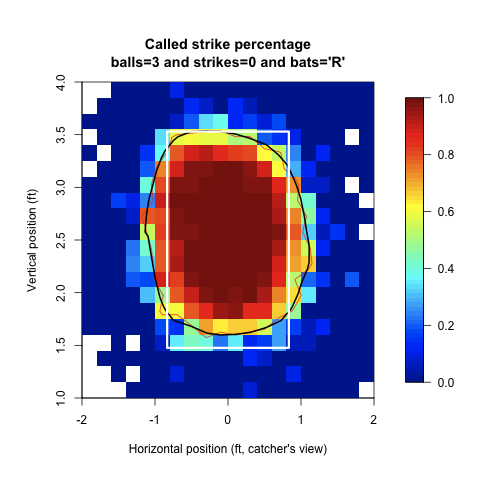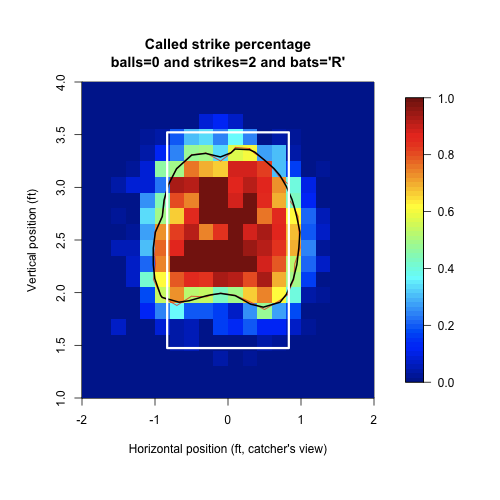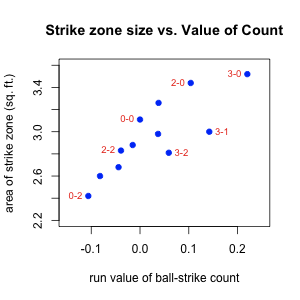You look at the the title of the article and the immediate reaction is "No way, no such thing" but after taking a look under the hood, I recognize some of the same qualities cited by our SABR-sleuthed author.
The relationship between the count and expected run value tells the tale as to why working the count is such an important component in hitting / pitching strategy and why ball / strike calls are the pivotal battle ground between players / coaches and umpires.
That's why it drives me nuts to see some hitters at the HS level and below operating in a state of seemingly blissful unawareness of the count. I don't know how they hit that way.
from the Hardball Times:
OK, now that I've got this new strike zone measuring toy, I thought I'd have a look at whether the size of the zone depends on the count. I think most of us have the intuition that on a 3-0 pitch, umpires will tend to call "anything close" a strike. Conversely, I have the notion (which turns out to be true) that when the hitter is in a deep hole, and 0-2 count, the umpires get picky on calling that third strike. Below you see the strike zone graphic separately for pitches thrown at 3-0 and 0-2, respectively.
More from the story:


It's as clear as day: These umpires are a bunch of softies. They see a pitcher struggling to put the ball over and they go all Gandhi on us, giving the pitcher an an extra chunk of strike zone to work with when the count reaches 3-0.
And when the batter becomes the underdog, when the count goes to 0-2? Why, the hearts of our merciful arbiters simply turn to mush: They can't help pulling for the poor batter as he chokes up on the bat, hoping to make some kind of contact. Who knew the umps were such empathetic characters?

I have always assumed that the umps call a different strike zone based on count only on the extreme pitchers' and hitters' counts. Sure, we see a big difference between 3-0 and 0-2, but the strike zone is more or less constant for the other counts, yes? Well, no
Interestingly, we see a very strong correlation between strike zone size and the run value of the count.* So, umps are (sub-consciously, to be sure) making small adjustments to the size of the strike zone depending on the count. And they are doing it in such a way as to help the underdog of the moment in the batter/pitcher matchup.
*You'll notice that the 3-2 count and, to a lesser degree, the 3-1 count do not follow the overall trend so well. I don't have a good reason for that, maybe the ump, after being generous with a called strike on 3-0, is less inclined to help out on 3-1? Possibly, but maybe it's just statistical scatter in the strike zone measurement.
References and Resources
Here is a table of the run values of ball-strike counts, taken directly from my previous article, "Searching for the game's best pitch".
+-------+-------------+ | Count | Run value | +-------+-------------+ | 0-0 | 0.000 | | 1-0 | 0.038 | | 2-0 | 0.104 | | 3-0 | 0.220 | | 0-1 | -0.044 | | 1-1 | -0.015 | | 2-1 | 0.037 | | 3-1 | 0.142 | | 0-2 | -0.106 | | 1-2 | -0.082 | | 2-2 | -0.039 | | 3-2 | 0.059 | +-------+-------------+
http://www.hardballtimes.com/main/article/searching-for-the-games-best-pitch/

No comments:
Post a Comment